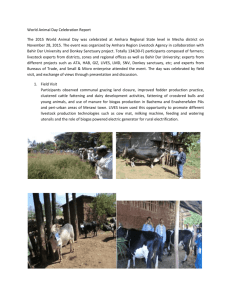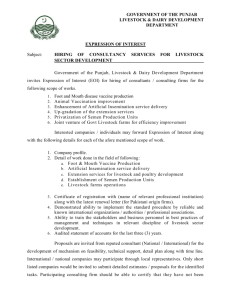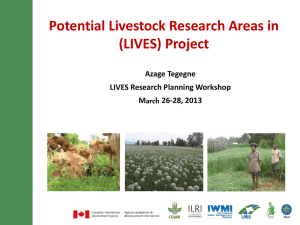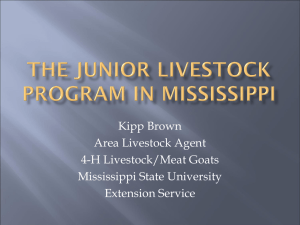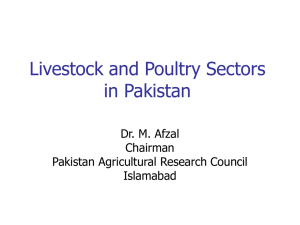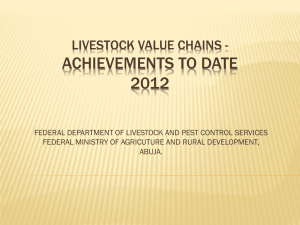ToT livestock training report Jan 2015 v4 - LIVES
advertisement
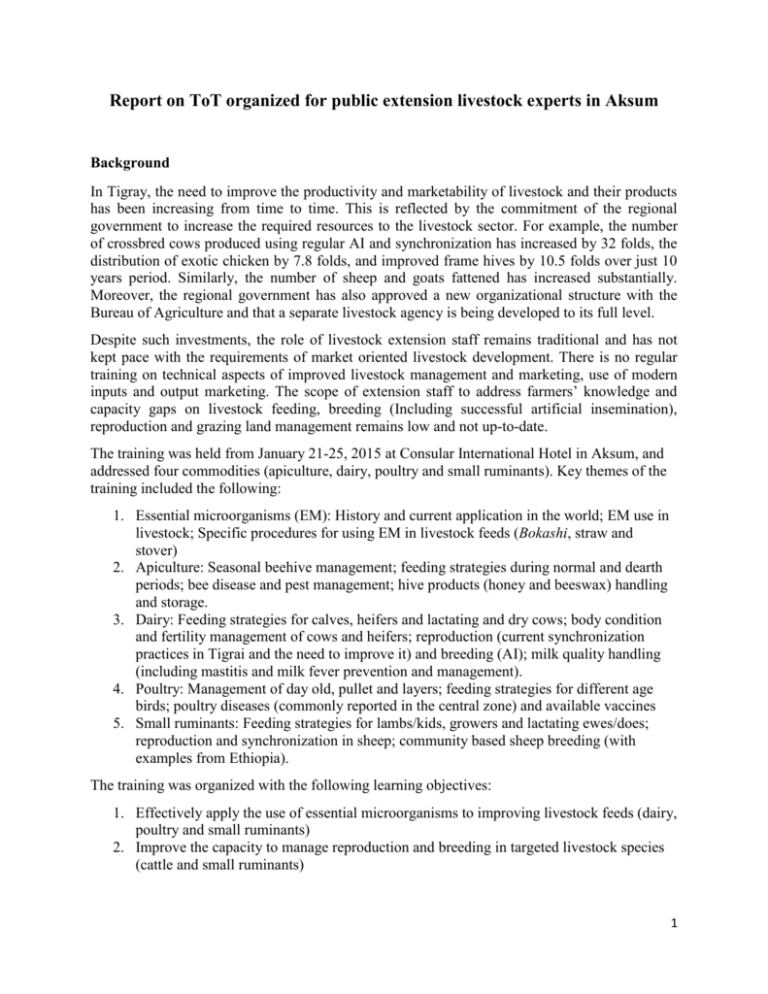
Report on ToT organized for public extension livestock experts in Aksum Background In Tigray, the need to improve the productivity and marketability of livestock and their products has been increasing from time to time. This is reflected by the commitment of the regional government to increase the required resources to the livestock sector. For example, the number of crossbred cows produced using regular AI and synchronization has increased by 32 folds, the distribution of exotic chicken by 7.8 folds, and improved frame hives by 10.5 folds over just 10 years period. Similarly, the number of sheep and goats fattened has increased substantially. Moreover, the regional government has also approved a new organizational structure with the Bureau of Agriculture and that a separate livestock agency is being developed to its full level. Despite such investments, the role of livestock extension staff remains traditional and has not kept pace with the requirements of market oriented livestock development. There is no regular training on technical aspects of improved livestock management and marketing, use of modern inputs and output marketing. The scope of extension staff to address farmers’ knowledge and capacity gaps on livestock feeding, breeding (Including successful artificial insemination), reproduction and grazing land management remains low and not up-to-date. The training was held from January 21-25, 2015 at Consular International Hotel in Aksum, and addressed four commodities (apiculture, dairy, poultry and small ruminants). Key themes of the training included the following: 1. Essential microorganisms (EM): History and current application in the world; EM use in livestock; Specific procedures for using EM in livestock feeds (Bokashi, straw and stover) 2. Apiculture: Seasonal beehive management; feeding strategies during normal and dearth periods; bee disease and pest management; hive products (honey and beeswax) handling and storage. 3. Dairy: Feeding strategies for calves, heifers and lactating and dry cows; body condition and fertility management of cows and heifers; reproduction (current synchronization practices in Tigrai and the need to improve it) and breeding (AI); milk quality handling (including mastitis and milk fever prevention and management). 4. Poultry: Management of day old, pullet and layers; feeding strategies for different age birds; poultry diseases (commonly reported in the central zone) and available vaccines 5. Small ruminants: Feeding strategies for lambs/kids, growers and lactating ewes/does; reproduction and synchronization in sheep; community based sheep breeding (with examples from Ethiopia). The training was organized with the following learning objectives: 1. Effectively apply the use of essential microorganisms to improving livestock feeds (dairy, poultry and small ruminants) 2. Improve the capacity to manage reproduction and breeding in targeted livestock species (cattle and small ruminants) 1 3. Formulate balanced complete ration for ruminant (dairy cattle and small ruminants) and monogastric (poultry) livestock 4. Improve the use of AI and synchronization techniques in increasing crossbred dairy cows 5. Improve honey quantity and quality 6. deliver market oriented livestock extension services for smallholder livestock keepers The training was held in Aksum from January 21-25, 2015 using facilities provided by Consolar International Hotel and attended by 34 participants (M=32; F=2). The training was facilitated by LIVES regional livestock expert and zonal coordinators. The facilitation process was fully participatory included a pre-training identification of major gaps hindering the realization of market oriented livestock development in the two LIVES action zones. This was followed by a clear understanding by higher level decision making bodies such as the regional livestock and health coordinator, zonal and district administrators, and heads of each district’s Office of Agriculture and Rural Development. Introduction session The training begun by highlighting unique capacity development approach of LIVES, and the specific commodities being addressed in each zone. This was followed by a brief reminder on commodity specific visions set during the zonal workshops in February 2013. Participants were then introduced themselves by explaining their specific area of expertise and experiences gained. Each participant was requested to reveal the expectations from each training topic and filled in a pre-and post-training evaluations, and briefed about housekeeping rules so that the training process can go without interruption. Side comments given during the training were immediately dealt with in so far as capacity of the facilitators permit. Scheduled training topics were delivered within the allocated time. The facilitation process included opening the forum for discussion, paraphrasing comments forwarded, and adding humours. Participants formed small groups and discussed key issues that needed further actions. These included the use of essential microorganisms (EM) stock in livestock feeding and means of creating sustained stock supply and improving the current livestock management skills of smallholder farmers through training and experience sharing visits. Participants also involved in a hands-on practical session on using EM for treating wheat bran and making Bokashi, EM treatment of barley straw and sorghum stover and feeding to cows and sheep, visited smallholder dairy and sheep farms (with clear written instructions) and presented their assessment of current herd management, exercised Pregtone for determining doe pregnancy status. All issues raised during the training were properly documented by zonal coordinators. An overview of the training program included the following: Day 1: Presentations on apiculture: feeding strategies, preparation of seasonal beehive activity calendar; dealing with beehives diseases and pests; honey quality. Day 2-Morning: Presentations on diary feeding and management of calves, heifers and cows; fertility management; lactation curve; feeding and rearing of calves and replacement heifers; nutritional needed of dry pregnant and lactation cows; the dairy hub approach as successfully implemented in Kenya. 2 Day 2-Afternoon: history of essential microorganisms (EM); application of EM in crops, waste management, and livestock; use of EM in improving low quality feeds and preparation of Bokashi; Practical session on treating wheat bran (20 kg), barley straw (20 kg), sorghum stover (20 kg) with EM solution. Day 3: Dairy reproduction and breeding: Current performance indicators of AI in Tigrai; alternative suggestions for synchronizing cows (based on the on-going student research); reproductive management and the use of Hormonost Microlab farmerstest kit. Day 4: Poultry (only for participants from the central zone): Poultry feeding and housing, hatchery management; diseases management and vaccination. Day 4: Small ruminants (only for participants from the eastern zone): Projected red meat demand in Ethiopia’s livestock master plan; nutritional management; reproduction and the use of prostaglandin based synchronization (application of Preg-Tone). Community based sheep breeding. Day 5: Action plan preparation and presentations (sample districts); way forward for livestock demonstration technologies; identifying agents for distributing EM stock A detail description of the training program is given in annex 2. Presentations and discussions Power point and flip chart presentations were used during the ToT. Apiculture: Power point presentations on apiculture included preparation of seasonal beehive activities including feeding, biological, management and environmental calendars. Major pests and diseases of honeybees and controlling strategies, feeding strategies during dearth periods, and hive product quality issues. Trainees prepared flowering calendar of major bee flora of their respective districts and discussed the practicability of such calendar by farmers. Adulteration of honey, uncontrolled use of pesticides in irrigated areas, and the introduction of new strains of small sized hives from other areas were discussed at length. They suggested that strengthening regulatory bodies and improving their capacity to identify adulterated honey; introducing honey marketing through recognized bodies such as cooperatives and creating critical mass who can control honey quality; increasing awareness through wider media coverage and working with private honey processing and exporting companies were some of the suggested solutions to improve the current problems on adulterated honey. Dairy: presentations on dairy included feed resources and their approximate energy concentration and protein content, feeding strategies for calves and growing heifers, pregnant lactating/dry cows and lactating cows; fertility management and body condition manipulation, and the dairy hub approach. Participants visited two dairy farms (one representing peri-urban and the other in a rural area) and presented their assessment of the two farms. The group in the periurban dairy tried to look at the whole dairy farm business and came up with crude profitability of the farm. The second group addressed a rural dairy farm and identified a number of management issues such as labour allocation, efficient use of land for producing own forage, market linkages with consumers. 3 Poultry: The presentations on poultry focused on locally available feeds and commercial ration marketed by Mekelle Farms, feeding strategies for different classes of birds, housing optionsincluding internal facilities and spacing, hatchery management, major diseases and available vaccines. Small ruminants: feed resources for growing and breeding sheep and goats; feeding of lambs, fattening stock and lactating ewes/does, the use of synchronization and community based sheep breeding. Participants also tested Preg-Tone to minimize risks associated with prostaglandin based synchronization protocols in small ruminants. EM: The use of EM in livestock, crops and environment, evolution of EM technology, safety issues, use of EM in livestock and poultry, steps for using EM in treating low quality feeds and making bokashi. Trainees took part in a half-day practical session and treated barley straw, sorghum stover and wheat bran using EM solutions. Questions raised by the ToT participants included safety issues, legal permission for importing EM and sustained supply to smallholder farmers. EM is completely natural made from lactobacilli, yeasts, and phototropic bacteria and so far no major concern is reported from over 140 countries who permitted its use. Ethiopia has formally recognized and permitted the use of EM. Ensuring sustained supply of EM stock is a major concern that needs the attention of public and private sector. Using unions and cooperatives as well as private companies as EM distributing agents were suggested by the trainees. Pre and post training evaluations Results of the pre and post training evaluations for each learning topic are indicated in the following figures. Before the training, the majority of the trainees in dairy development had an average knowledge of the seven learning objectives included in the ToT. This was improved to good and very good after the training (Fig. 1). Similarly, trainees’ knowledge of apiculture as evaluated using 5 learning objectives was improved from average to good, very good and excellent (Fig. 2). The proportion of learners who had average knowledge about poultry (Fig. 3) and small ruminants (Fig. 4) was also improved to above average ratings after the training. A clear reversing of the ratings of about knowledge of trainees on EM use was observed, and most scored an excellent after the training (Fig. 5) Figure 1. Ratings of trainees on their knowledge of dairy before and after training. 4 Figure 2. Ratings of trainees on their knowledge of apiculture before and after training. Figure 3. Ratings of trainees on their knowledge of poultry before and after training. Figure 4. Ratings of trainees on their knowledge of small ruminants before and after training. 5 Figure 5. Ratings of trainees on their knowledge of EM use before and after training. Next steps/Follow up action plans Finally, trainees agreed to develop a detailed district level action plans (see annex 3) and promised to provide similar training for smallholder farmers. They feared that high decision making officials may not be willing to allocate sufficient time for livestock related activities including intensive training of smallholder farmers, and this will be discussed further with each district’s heads of the Office of Agriculture and Rural Development as well as district administrators. 6 Annexes 1. Annex 1: List of participants in the ToT for district livestock experts January 21-25, 2015, Aksum SN Name Sex Profession District 1. Gebre-Kiros Gebre-Selama M Livestock coordinator Atsbi-Womberta 2. Bahlen Gebremicael F Forage Atsbi-Womberta 3. Mulugeta Gebretsadik M Breeding Atsbi-Womberta 4. Tesfay Gebru M Livestock coordinator Kilte-Awlaelo 5. Muez Legesse M Forage Kilte-Awlaelo 6. Teame Hailu M Apiculture Kilte-Awlaelo 7. Fikreselassie Kebede M Breeding Kilte-Awlaelo 8. Haileselassie Gidey M Livestock coordinator Saesie-Tsaeda Emba 9. Gidey Tesfamicael M Apiculture Saesie-Tsaeda Emba 10. Mebrehit Gebrehiwot F Forage Saesie-Tsaeda Emba 11. Mulu Mehari M Breeding Saesie-Tsaeda Emba 12. Gebrecherkos Gebremeskel M Livestock coordinator Ganta Afeshum 13. Tsegabu Gebrekidan M Apiculture Ganta Afeshum 14. Shambel Gidey M Breeding Ganta Afeshum 15. Meseret Gebre-giorgis F Forage Ganta Afeshum 16. Atakilty Arefe M Zonal expert Eastern Zone 17. Gebremedhin Girmay M Livestock coordinator Ahferom 18. Sahle Gebreselassie M Forage Ahferom 19. Tesfay Halefom M Breeding Ahferom 20. Aklilu Mezgebe M Poultry Ahferom 21. Teklewoiny Gebrerufael M Apiculture Ahferom 22. Negash mohammed M Livestock coordinator Adwa 23. Seifu Tadesse M Poultry Adwa 24. Gebrehiwot Addissu M Apiculture Adwa 25. Gebrehiwot Gebremicael M Breeding Adwa 7 26. Hawaria Weres M Forage Adwa 27. Leake Tesfamariam M Livestock coordinator Laelay Maichew 28. Mulu Gebrehiwot M Poultry Laelay Maichew 29. Alemayehu Gebrekristos M Forage Laelay Maichew 30. Alem Sebhat M Apiculture Laelay Maichew 31. Teklegiorgis Assefa M Zonal livestock expert Central Zone 32. Getachew Teklehaimanot M Regional forage expert Region 33. Mussie Girmay M Regional breeding expert Region 34. Gebreselassie Hagos M Regional poultry expert Region 8 2. Annex 2: ToT program Date January 21, 2015: Feed Improvement January 21, 2015: Apiculture Time Event Facilitator 8:00-8:30 Registration Amare 8:30-9:00 Introduction and gap identification questionnaire Yayneshet 9:00-10:30 EM use for improving fibrous feeds Gedion 10:30-11:00 Health break LIVES 11:00-12:30 EM use for improving fibrous feeds Gedion 12:30-14:00 Lunch Self 14:00-15:30 Practical demonstration Gedion/Dawit/Haile/Yayneshet 15:30-16:00 Health break LIVES 16:00-17:30 Practical demonstration Gedion/Dawit/Haile/Yayneshet 17:30-18:30 Discussion/Feedback/action plan Yayneshet 8:00-830 Registration Amare 8:30-9:00 Introduction and gap identification questionnaire Dawit/Haile 9:00-10:30 Honeybee feeding strategies Haftom/Guesh 10:30-11:00 Health break LIVES 11:00-12:30 Honeybee pests and diseases; seasonal colony management Haftom/Guesh 12:30-14:00 Lunch Self 14:00-15:30 Queen rearing and management Haftom/Guesh 15:30-16:00 Health break LIVES 16:00-17:30 Hive product handling/quality control (Honey and beeswax) Haftom/Guesh 17:30-18:30 Discussion/Feedback/action plan Yayneshet 9 January 22, 2015: Feed Improvement January 23, 2015: Dairy Management January 24, 8:30-9:00 Introduction and gap identification questionnaire Yayneshet 9:00-10:30 EM use for improving fibrous feeds Gedion 10:30-11:00 Health break LIVES 11:00-12:30 EM use for improving fibrous feeds Gedion 12:30-14:00 Lunch Self 14:00-15:30 Practical demonstration Gedion/Dawit/Haile/Yayneshet 15:30-16:00 Health break LIVES 16:00-17:30 Practical demonstration Gedion/Dawit/Haile/Yayneshet 17:30-18:30 Discussion/Feedback/action plan Yayneshet 8:30-9:00 Gap identification questionnaire Dawit/Haile 9:00-10:30 Feeding of calves and replacement heifers, dry pregnant and lactating cows Yayneshet 10:30-11:00 Health break LIVES 11:00-12:30 Reproductive management Tadesse/Desta-Alem 12:30-14:00 Lunch Self 14:00-15:30 Reproductive management Tadesse/Desta-Alem 15:30-16:00 Health break LIVES 16:00-17:30 Milk handling and processing Haftom 17:30-18:30 Discussion/Feedback/action plan Yayneshet 8:30-9:00 Gap identification questionnaire Haile 9:00-10:30 Feeding and day old chicks, pullets, and layers Bruh/Mekelle Farm 10:30-11:00 Health break LIVES 11:00-12:30 Poultry housing designs Bruh 12:30-14:00 Lunch Self 10 2015: Poultry Management (parallel session) 14:00-15:30 Poultry diseases management Mekelle Farm 15:30-16:00 Health break LIVES 16:00-17:30 Hatchery management Bruh 17:30-18:30 Discussion/Feedback/action plan Haile/Bruh 8:30-9:00 Gap identification questionnaire Dawit 9:00-10:30 Small ruminant feeding strategies Yayneshet January 24, 2015: Small ruminant management (parallel session) 10:30-11:00 Health break LIVES 11:00-12:30 Small ruminant feeding strategies Yayneshet 12:30-14:00 Lunch Self 14:00-15:30 Reproductive management Yayneshet 15:30-16:00 Health break LIVES 16:00-17:30 Community based sheep breeding Yayneshet 17:30-18:30 Discussion/Feedback/action plan Yayneshet/Dawit Whole day Action plan preparation and presentation; Demonstration materials use; identifying potential EM suppliers/agents Yayneshet/Dawit/Haile January 25, 2015: 11 3. Annex 3: Sample action plans Ahferom Apiculture 1 2 Activities Parti cipan t no Training farmers 30 Bee technician 3 DAs 3 Training activities 2.1 Honeybee feeding strategies 2.2 Honeybee pest and diseases 2.3 Seasonal colony management 2.5 Beekeeping on transitional hive Why /purpose How /Method To improve the production and productivity of honey and honeybees on small-scale farmers in related market linkage system To create and support available service for the farmers Theore tical and video supported Two way learning system Group desiccation on phenomena Experience sharing on best farms Practical on field When/Ti me frame With whom? LIVES Support needed /from whom Materials needed LIVES Researc h center Manual (cd ppt) Stationery Honey container Re fractometer February 18-20/2015 S/n 3 NB;- Facilitator and trainers #1 12 Dairy 1 2 Activities Training Farmers 40 AI technician 2 Animal health assistance 4 Das 3 Cooperative /union 1 Training activities 2.1 Feeding heifer ,lactating caw, calves 2.2 Housing management 2.3 Feed implementing using EM and urea treatment 2.4 Vaccination and treatment calendar 2.5 AI calendar 3 Parti cipan t no Why /purpose To improve the production and productivity of dairy caws on small-scale farmers in related market linkage system To improve Ingenious breed To create and support available Extension service for the farmers How /Method Theore tical and video supported Two way learning system Group desiccation on phenomena Experience sharing on best farms Practical on field When/Ti me frame With whom? LIVES BOARD Woreda and tabia Administrat or Input supply Februar22-224/2015 S/n Support needed /from whom Materials needed LIVES Researc h Center Lactometer Manual (cd ppt) Stationery 6 litter EM 16 litter molasses 80kg wheat bran 2m*2m Plastic sheet 20 kg urea 8 Bucket 40 litter EM introducing to the farmers and implementing the each farmer 13 Poultry 1 2 Activities Parti cipan t no Training Farmers 40 Animal health assistance 4 Das 3 Poultry agent 2 Training activities 2.1 Feeding and handling of day-old chicken, pullets and layers 2.2 Housing management and design 2.3 Vaccination and treatment calendar 2.4 Biosecurity 3 Using EM treated feed in 40 farmers 4 Constricting Model poultry house in 5 farmers Why /purpose How /Method To improve the production and productivity of chickens on smallscale farmers in related market linkage system To create and support available Extension service for the farmers Theore tical and video supported Two way learning system Group desiccation on phenomena Experience sharing on best farms Practical on field When/Ti me frame With whom? LIVES BOARD Woreda and tabia Administrat or Input Support needed /from whom LIVES Researc h Center Materials needed Feeder and drinker Manual (cd ppt) Stationery Mesh wire supply February 26-28/2015 S/n 14 Laelay Maichew Dairy What activity Why(purpose) I. Feeding of calves, farmers have low replacement heifers, knowledge & Skill dry pregnant cows& Lactating cows II.Reproductive management of dairy cows the farmers low knowhow on reproductive of cow III.Milking procedures & Milking handling methods the farmers have misunderstand/gaps on milking & How(method) Theoretical and by practical trianing, preparing Training manual, by pictures& video show Group discussions & experience sharing Theoretical and by practical training, preparing Training manual, by pictures& video show Group discussions &by best experience sharing Theoretical and by practical training, preparing Training . When( Time Frame) January 810/2007 January 810/2007 With Whom? (Stockholder) Supported need (From whom) LIVES wereda Stationeries-LIVE materials-Wereda & DA'S LIVES LIVES Videos ,Pictures wereda DA'S January 810/2007 LIVES Videos ,Pictures- wereda DA'S Milking materials (LIVES& wereda) 15 handlings IV.EM Uses for improving fibrous feeds& its It is a new technology to the farmers applications VI. Practical demonstration farmers have low on EM, urea Treatment, knowledge in Skill urea molasses block, silage manual, by pictures& video show Group discussions &by best experience sharing Theoretical and by practical training, preparing Training manual, by pictures& video show Group discussions preparing training manual, Theoretical and practical training using pictures& video show group discussions Beekeeping What activity I. Training on bee keeping calendar Why(purpose) Upgrade the knoiwlege &Skill of the beekeeper How(method) Theoretical and by practical training, preparing Training manual, cooperative lekatit 8-10/2007 LIVES EM, Molasess, wereda Wheat Bran-LIVES DA'S cooperative January 810/2007 . When( Time Frame) January1214/2007 wereda EM, Molasses, DA'S Wheat Bran-LIVES With Whom? (Stockholder) Supported need (From whom) LIVES wereda Stationeries-LIVE materials-wereda & DA'S LIVES 16 by pictures& video show Group discussions II. Seasonal management of honey bee colonies III. Honeybee feeding management & Strategies Farmers have Shortage of skill & Knowhow There are gaps on skill knowledge &Skill of farmers IV.Honey bee apiary site selection There are gaps on skill knowledge &Skill of farmers V.How to prepare of honey There are gaps on skill bee flora calendar, knowledge &Skill of Productivity , farmers Theoretical and by practical training, preparing Training manual, by pictures& video show Group discussions Theoretical and practical training, preparing Training manual, by pictures& video show Group discussions Theoretical and by practical training, preparing Training manual, Theoretical and by practical training, preparing Training manual, January1214/2007 LIVES wereda DA'S January1214/2007 LIVES wereda DA'S January1214/2007 LIVES wereda DA'S January1214/2007 LIVES wereda DA'S 17 Poultry . What activity Why(purpose) I. Feeding& feeding management day old chicks, farmers have Shortage of skill & Knowhow pullets& layers II. Housing design of poultry There are gaps on skill knowledge &Skill of farmers III. Hatchery management There are gaps on skill knowledge &Skill of farmers IV. Poultry Predators, pests & diseases management There are gaps on skill knowledge &Skill of farmers How(method) Theoretical and practical training, preparing Training manual, by pictures& Group discussions Theoretical and practical training, preparing Training manual, by pictures& Group discussions Theoretical training, preparing Training manual, by pictures& Group discussions Theoretical training, preparing Training manual, by pictures& Group discussions When( Time Frame) January1618/2007 January1618/2007 With Whom? (Stockholder) Supported need (From whom) LIVES wereda Stationeries-LIVE materials-wereda DA'S &LIVES LIVES wereda DA'S January1618/2007 LIVES wereda DA'S January1618/2007 LIVES wereda DA'S 18
